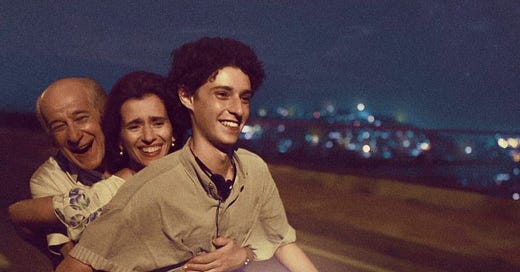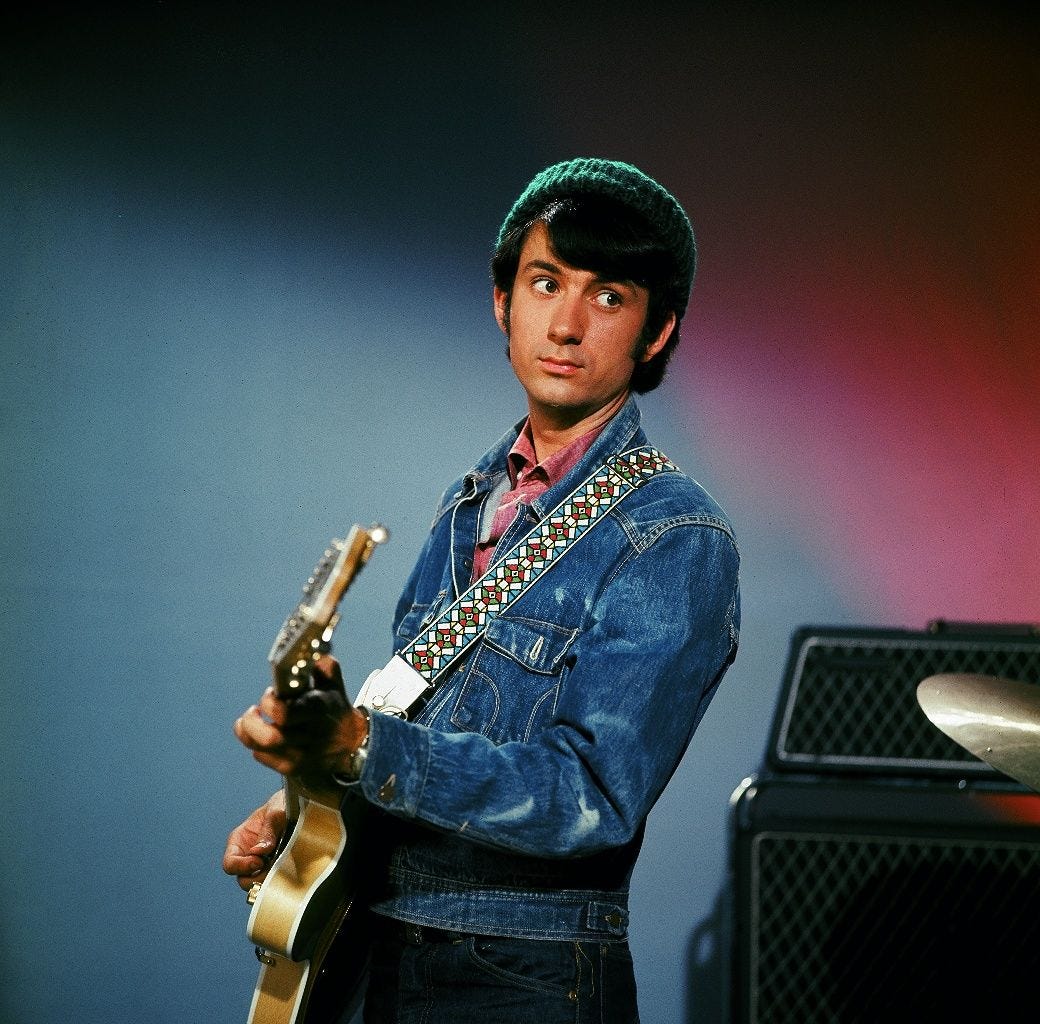See Naples And Live
"The Hand of God," on Netflix, is a memory play that vividly recreates a director's youth. Plus: Remembering Mike Nesmith.
The Nut Graf1: Paolo Sorrentino’s “The Hand of God” (in theaters and on Netflix, ***1/2 stars out of ****) is “The Great Beauty” director’s most personal work to date, a charming and moving account of a Naples adolescence. Also: What Michael Nesmith leaves behind.
Can an artist be wholly in the thrall of an earlier master and still have his own voice? The Italian writer-director Paolo Sorrentino makes certain critics and moviegoers testy because he absorbed the films of Federico Fellini at a molecular level in his youth, and his own movies can seem made from recombinant DNA. “The Great Beauty” (2013) is Sorrentino’s high-water mark to date, an Oscar winner for Best International Film and an audiovisual high-wire act about hedonism and regret that needs to be savored on a big screen or via Blu-ray. Melancholy, funny, vulgar, and profound, “The Great Beauty” tries to pack it all in – it is truly a grande bellezza.
“Beauty” owed more than a bit to the 1960 Fellini classic “La Dolce Vita,” which put some noses out of joint, and Sorrentino’s sweet but lackluster follow-up, “Youth” (2015), centered on the creative block of an aging artist (Michael Caine) in ways that dared comparison with the maestro’s “8 1/2” (1963). Now comes “The Hand of God” – it arrives on Netflix today on the heels of a limited theatrical release – and it is the most personal Sorrentino to date, a memory play about the filmmaker’s adolescence in the 1980s and a warm love letter to his parents and to Naples. The shadow of Fellini flits about the new film’s frames, but he is mostly replaced by the other god in Sorrentino’s pantheon, the legendary football player Diego Maradona. (In his Oscar acceptance speech for “The Great Beauty,” the director thanked both men, Martin Scorsese, and Talking Heads.) It’s a charming movie, Sorrentino’s most accessible by far, and a good entry point for newcomers.
The rap against this director – that he’s more style than substance – has been largely laid to rest in the critical response to “The Hand of God.” Anyway, to me Sorrentino has always been about style as emotion, as a way to evoke states of feeling that only cinema makes possible. Those feelings find a more concrete vessel in this coming-of-age story, which casts a gangly Filippo Scotti as the director’s stand-in, Fabietto, and the altogether wonderful Toni Servillo and Teresa Saponangelo as his parents, Saverio and Maria. Servillo is a Sorrentino regular, star of “The Great Beauty” and of the 2018 Silvio Berlusconi satire “Loro,” and he has the rubbery face and mischievous gleam of the great clowns. As Maria, Saponangelo isn’t some sainted mother-figure but an imp in her own right, given to pranking the stuffy neighbors and juggling oranges. Seen through a growing child’s eyes, their marriage is all one could hope for in one’s parents: Loving and playful, familiar and fresh. Only as the movie progresses do we learn of hidden sorrows.
Various relatives and characters whirl around this central trio: A brother (Marlon Joubert) who wants to audition for Fellini but is told his face is “too conventional,” a sister who’s always in the bathroom, uncles and cousins, a down-on-her-heels Contessa in the apartment upstairs, an aging suitor with an electronic voicebox, and a scandalous, voluptuous aunt (Luisa Ranieri) whose inability to have a child has frayed her sanity and led her to sunbathe nude in public and flirt lovingly with her favorite nephew. (As with Fellini, Sorrentino adores bountiful women with a relish that some may find misogynistic and others simply Italian.) When asked if he had to choose between this goddess and Maradona, who’s rumored to be coming to play for Naples, Fabietto picks the obvious. As they say on “Ted Lasso,” football is life.
Indeed, “The Hand of God” takes its name from a controversial goal scored by Maradona during the quarterfinals match of the 1986 World Cup (the game plays on TV during the film). The title also applies to a moment in its young hero’s life, a cataclysm that occurs precisely halfway through the movie and divides it into a Before and After. I won’t spoil it other than to say that the event replicates a tragedy in Sorrentino’s past and that the episodic nature of the scenes that follow – which some critics have found aimless and slack – make perfect sense, in their unwinding, to anyone who has suffered a primal family loss in their youth. (I’m among those raising a hand here.)
Sorrentino’s least phantasmagoric film to date, “The Hand of God” still seeks and finds magic moments of sound and light, nanoseconds of pure presence. The sound of a speedboat bouncing along the waves at top speed – “touf… touf… touf…” – is a repeated motif, heard even under the final credits, as if the director were beating back against the current to find who he once was. One senses Sorrentino facing away from us as he uses cinema not as “a distraction from reality” (as someone in the film reports Fellini saying) but as a way to return to it. In “The Hand of God,” he’s not recreating the past for an audience. He’s getting it right for himself.
On another subject and in another medium, I’ve been going down a Mike Nesmith rabbit hole since learning of his death December 10. The man was my favorite Monkee, then and now – something about the way he held himself back from the pre-fabricated antics of the TV show struck me as classy and, in the circumstances, judicious – and his biography is one of the more singular in 20th-century pop culture. His mother was a secretary who invented Wite-Out™, setting the family up for life; more to the point, Nesmith was a critical figure in several post-Monkees fields. With 1977’s “Rio,” he made one of the first music videos as we now understand the form and went on to create a music-video TV show, “PopClips,” that was sold in 1980 to Time Warner, which used it as the template for MTV. He won the first Grammy for Video of the Year for 1982’s music-comedy special “Elephant Parts.” And as a film producer, he is responsible for “Repo Man” (1984), one of the few movies that can legitimately be called Punk.
But it’s Nesmith’s status as a founding father of country rock that I’ve been celebrating and exploring this week. Along with Gram Parsons, The Flying Burrito Brothers, and The Byrds circa 1968’s “Sweetheart of the Rodeo,” Nesmith fused two genres that were at the time considered antithetical – either you were a longhair or you were an Okie from Muskogee who beat up longhairs – and went on to make the world safe for The Eagles and Pure Prairie League. He could turn out a fine pop song, as anyone knows who has heard Linda Ronstadt and the Stone Poney’s hit version of Nesmith’s “Different Drum,” but it was with his First National Band and the group’s three albums – “Magnetic South” (1970), “Loose Salute” (1970), and “Nevada Fighter” (1971) – that he forged something new and lasting. “Magnetic South” especially belongs with “Sweetheart” and the Burrito’s “The Gilded Palace of Sin” (1969) as part of a Holy Trinity of country rock, and Nesmith’s ironically titled 1972 release “And the Hits Just Keep On Comin’,” recorded with just him and pedal-steel player Red Rhodes, is a haunting, stripped-down version of same – a simply lovely record.
There’s a case to be made for Nesmith as preparing this ground during his days in the Monkees. On hearing of the musician’s death, my friend Phil Obbard shared a YouTube playlist he had made of “the solo album Nez (of the Monkees) should have released in 1968/69!,” cobbled together from various songs Nesmith penned and recorded with the group. If you don’t have YouTube Music, I’ve replicated Phil’s playlist on Spotify:
Rest in peace, my dude.
If you enjoyed this edition of Ty Burr’s Watch List, please feel free to share it with friends.
If you’re not a paying subscriber and would like to sign up for additional postings and to join the discussions, here’s how:
If you’re already a paying subscriber, I thank you for your generous support.







